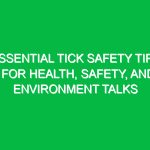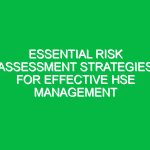In today’s fast-paced industrial landscape, a well-structured risk assessment report is crucial for ensuring health, safety, and environmental (HSE) success. The format of these reports not only serves as a framework for identifying and mitigating potential risks but also demonstrates an organization’s commitment to maintaining a safe working Environment. In this article, we will delve into the essential components of a risk assessment report format, explore its relevance in the HSE domain, and provide actionable insights to enhance your organization’s Safety protocols.
Understanding Risk Assessment Report Format
A risk assessment report format outlines how to systematically analyze potential Hazards and their associated risks. It serves as a comprehensive document that guides organizations in identifying, evaluating, and mitigating risks effectively. The relevance of this format in the HSE context cannot be overstated; it not only helps in compliance with legal requirements but also promotes a culture of Safety and environmental accountability.
Key Elements of a Risk Assessment Report Format
To craft an effective risk assessment report, certain key elements must be included. Each component plays a vital role in ensuring clarity, consistency, and comprehensiveness. Below are the essential sections typically found in a thorough risk assessment report format:
- Title Page: This should include the report title, date of assessment, and the names of the individuals involved in the assessment.
- Table of Contents: A navigable outline of the report sections for easy reference.
- Introduction: An overview of the purpose of the risk assessment and its significance within the HSE framework.
- Scope of the Assessment: A clear definition of the areas, processes, or activities being assessed.
- Methodology: A description of the techniques and tools used to conduct the risk assessment, including qualitative and quantitative approaches.
- Hazard Identification: A detailed list of potential Hazards associated with the processes or activities being analyzed.
- Risk Evaluation: An assessment of the likelihood and severity of risks associated with identified hazards.
- Risk Control Measures: Recommendations for mitigating identified risks, including both engineering controls and administrative measures.
- Action Plan: A timeline and responsibilities for implementing risk Control Measures.
- Conclusion: A summary of findings and essential recommendations for ongoing safety improvements.
- Appendices: Additional supporting documentation or data relevant to the assessment.
Exploring Each Component in Detail
Title Page
The title page sets the stage for the report. It should be clear and concise, providing essential information such as the report’s title, the date of assessment, and the names of the assessors. For example, a title might read, “Risk Assessment Report for Warehouse Operations – March 2023.”
Table of Contents
A well-organized table of contents allows readers to navigate the report efficiently. Each section should be clearly labeled, and page numbers should be included for ease of access.
Introduction
The introduction should articulate the necessity of the risk assessment and contextualize it within HSE principles. It is essential to emphasize how risk assessments contribute to Workplace Safety and regulatory compliance.
Scope of the Assessment
This section defines the boundaries of the assessment. It should specify the processes, locations, and activities analyzed, providing a clear understanding of what is included and what is not.
Methodology
In this section, the methods utilized for the risk assessment should be described in detail. This might include techniques such as hazard identification workshops, checklists, and interviews with employees. Each method should be justified, demonstrating its relevance and effectiveness in identifying risks.
Hazard Identification
Hazard identification is crucial for any risk assessment. This section should present a structured approach to listing potential hazards. Real-life examples, such as chemical spills in manufacturing plants or equipment malfunctions in construction sites, can illustrate common hazards. It’s important to involve employees in this process, as they often have firsthand knowledge of risks.
Risk Evaluation
Once hazards are identified, the next step is to evaluate the risks associated with them. This involves determining the likelihood of an incident occurring and the potential impact it may have. A risk matrix can be a useful tool here, categorizing risks into low, medium, and high levels based on severity and probability.
Risk Control Measures
Effective risk control measures are essential for mitigating identified risks. This section should outline both engineering and administrative controls. For instance, in a manufacturing environment, engineering controls might include ventilation systems to reduce exposure to hazardous fumes, while administrative controls could involve regular safety Training for employees.
Action Plan
The action plan should detail the steps necessary to implement the recommended risk control measures. It should assign responsibilities to specific individuals or teams and set timelines for completion. For example, if a new safety protocol is proposed, the plan should outline who is responsible for training employees and when this training will occur.
Conclusion
The conclusion should summarize the key findings of the risk assessment and reiterate the importance of implementing the recommended measures. It is an opportunity to reflect on the overall safety culture within the organization and encourage ongoing risk management practices.
Real-Life Examples and Case Studies
To further illustrate the significance of a well-structured risk assessment report format, consider the case of a construction company that faced several safety incidents due to inadequate risk assessments. After a thorough review, the company adopted a standardized risk assessment report format, which included detailed hazard identification and control measures. Over the next year, the company reported a 40% decrease in workplace accidents, demonstrating the efficacy of a clear and comprehensive risk assessment format.
Another example can be drawn from the oil and gas industry, where risk assessment reports are critical due to the high-stakes environment. A major oil company utilized a risk assessment report format that highlighted not only immediate hazards but also potential environmental impacts. This proactive approach led to the development of robust contingency plans, significantly reducing the likelihood of spills and improving overall safety performance.
Regulations and Standards Governing Risk Assessment Report Format
In the HSE context, various Regulations and standards govern the format and content of risk assessment reports. For instance, the Occupational Safety and Health Administration (OSHA) in the United States mandates that employers conduct and document risk assessments to ensure Workplace Safety. Compliance with such regulations not only protects employees but also shields organizations from potential legal liabilities.
Additionally, international standards such as ISO 45001 provide guidelines for Occupational Health and safety management systems, emphasizing the importance of risk assessment. Organizations that adhere to these standards are better positioned to manage safety risks effectively and enhance their reputations.
Best Practices for Implementing a Risk Assessment Report Format
To ensure the effectiveness of a risk assessment report format, organizations should consider the following Best Practices:
- Involve Employees: Engage employees in the risk assessment process, as they possess valuable insights into potential hazards.
- Regular Reviews: Conduct regular reviews and updates of risk assessment reports to reflect changes in operations or regulations.
- Training: Provide training for employees on the importance of risk assessments and how to identify hazards.
- Utilize Technology: Consider using software solutions that streamline the risk assessment process and enhance data analysis.
- Encourage Feedback: Foster an environment where employees feel comfortable providing feedback on safety practices and reporting hazards.
Conclusion
In conclusion, the format of a risk assessment report is integral to achieving HSE success. By incorporating the essential elements discussed in this article, organizations can enhance their risk management practices, promote a culture of safety, and ensure compliance with relevant regulations. As the landscape of Workplace Safety continues to evolve, a well-structured risk assessment report will remain a cornerstone of effective health, safety, and environmental management. Organizations are encouraged to continually refine their risk assessment report formats and practices, fostering a proactive approach to safety that Benefits both employees and the environment.


